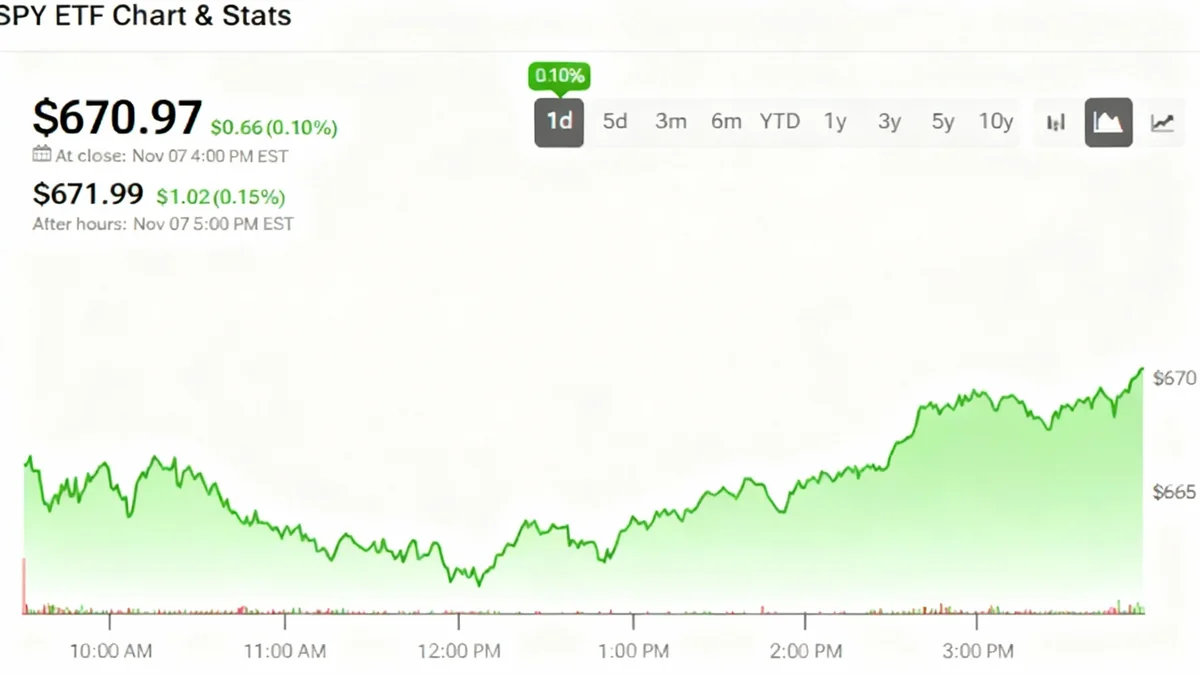U.S. stocks concluded a turbulent week with a mixed performance on Friday, November 7, marking the first weekly decline for major indexes in four weeks. The S&P 500 and Dow Jones Industrial Average managed to reverse earlier losses to close slightly higher, while the tech-heavy Nasdaq finished in the red, highlighting persistent volatility in the technology sector.
The market's indecisive close reflects growing investor uncertainty, fueled by a mixed bag of corporate earnings and a prolonged U.S. government shutdown that is withholding critical economic data from both Wall Street and the Federal Reserve.
Key Takeaways
- Major U.S. stock indexes recorded their first weekly loss after three consecutive weeks of gains.
- The S&P 500 rose 0.1% to 6,728.80, and the Dow Jones Industrial Average gained 0.2% to 46,987.10 after recovering from earlier declines.
- The Nasdaq Composite fell 0.2% to 23,004.54, pulled down by weakness in major technology stocks.
- A prolonged government shutdown is preventing the release of key economic data, including employment and inflation reports, creating uncertainty for investors and the Federal Reserve.
- Consumer sentiment has dropped to a three-year low, signaling concerns about the shutdown's economic impact.
A Week of Wavering Confidence
Wall Street struggled to find direction throughout the week, pulling back from record highs set the previous week. Friday's trading session was a microcosm of this uncertainty. At one point, the S&P 500 was down by as much as 1.3%, and the Nasdaq had plunged 2.1% before a late-day rally helped pare most of those losses.
The Dow ultimately finished up by 74.80 points, while the S&P 500 added 8.48 points. The Nasdaq's loss of 49.46 points underscored the pressure facing the technology sector, which has been a primary driver of market gains this year.
Tech Sector Shows Signs of Strain
The influence of mega-cap technology stocks was on full display. These companies carry such large valuations that their performance can dictate the direction of the broader market. On Friday, several key players acted as a drag on the indexes.
Shares of Google's parent company, Alphabet, fell 2.1%, while chipmaker Broadcom declined 1.7%. This weakness in big tech was a significant factor in the Nasdaq's negative close and contributed to the market's overall hesitant tone.
By the Numbers
- S&P 500: +0.1% to 6,728.80
- Dow Jones: +0.2% to 46,987.10
- Nasdaq: -0.2% to 23,004.54
- 10-Year Treasury Yield: Held steady at 4.09%
Corporate Earnings Tell a Divided Story
Investors remained sharply focused on the latest wave of quarterly corporate earnings reports, which have provided a mixed view of the business landscape. While overall earnings have been strong, individual company results have triggered significant market moves.
Payments company Block, which operates Square and Cash App, saw its stock sink 7.7% after its financial results failed to meet analyst forecasts. This disappointment highlights the high expectations investors have placed on growth-oriented tech firms.
In contrast, some companies delivered positive surprises. Exercise equipment maker Peloton jumped 14.2% after its results beat Wall Street estimates, suggesting a potential turnaround. Similarly, Expedia Group surged an impressive 17.5% after the travel company's earnings surpassed expectations.
According to data from FactSet, more than 90% of companies in the S&P 500 have now reported their quarterly results. The majority have exceeded expectations, with the technology sector reporting the strongest overall growth. However, the market's reaction has been selective, rewarding outperformers and punishing those that fall short.
The Government Shutdown's Growing Impact
The U.S. government shutdown, now the longest on record, is casting a long shadow over financial markets. The primary issue for investors is the lack of reliable economic data. The Bureau of Labor Statistics was unable to release the monthly employment reports for both September and October. This leaves a significant blind spot regarding the health of the U.S. job market, which had already shown signs of weakening.
Economic Uncertainty and the Fed's Dilemma
The absence of official government data is forcing investors and policymakers to rely on private sources of information, which can be less comprehensive. A key report released Friday from the University of Michigan revealed that consumer sentiment fell sharply in the latest survey, hitting a three-year low.
This decline suggests that the public is becoming increasingly worried about the economic consequences of the shutdown. Eugenio Aleman, chief economist for Raymond James, noted the shift in public mood.
“Consumers are starting to get concerned about the potential effects of the government’s shutdown on economic activity,” Aleman wrote in a note to investors.
The survey also indicated that consumer expectations for inflation have ticked slightly higher. This combination of weakening consumer confidence and persistent inflation creates a challenging environment for the Federal Reserve.
Interest Rate Questions Loom
The Fed has signaled a more cautious approach to future interest rate cuts after implementing two reductions earlier this year. These cuts were intended to support economic growth amid a cooling labor market. However, with inflation remaining stubbornly above the central bank's 2% target, further cuts could risk pushing prices even higher.
The lack of official employment and inflation data makes the Fed's next decision incredibly difficult. Despite this, market participants are still largely betting on another rate cut. According to the CME FedWatch Tool, investors are pricing in a 67% probability of an interest rate cut at the Fed's December meeting.
In the bond market, Treasury yields remained stable, with the 10-year Treasury yield holding at 4.09% and the two-year yield at 3.56%, suggesting that bond investors are in a holding pattern as they await more clarity.
Global Markets Feel the Pressure
The uncertainty in U.S. markets was reflected globally. European indexes fell, and Asian markets closed lower. Economic data from China added to the cautious sentiment, with a report showing that the country's exports contracted by 1.1% in October. Shipments to the United States were particularly weak, dropping 25% from a year earlier, a clear sign of the ongoing impact of trade tensions.





